General election 2019: preview of North West England
The 2019 general election presents voters with a complex task of choosing which party can best represent their Leave versus Remain view, as well as their broader policy preferences. The picture is complicated further by distinct regional variations. In the second of our preview articles, the Democratic Audit team assesses the key contests and political divides in the North West of England, focusing on the seats identified from the 2017 results, the latest polling, and how insurgent parties and the Leave-Remain background affect the contest in each area.
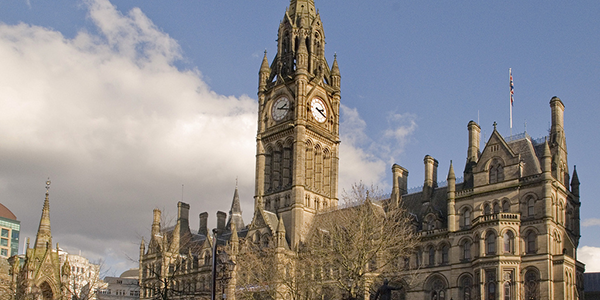
Manchester Town Hall. Picture: Mark Andrew/Wikipedia/(CC BY 2.0) licence
Encompassing Cumbria, Lancashire, Merseyside, Greater Manchester and Cheshire, the North West is always majority Labour. In the 2017 general election the party won 54 of the 75 seats in the region, making it a key target for the Conservatives if they are to gain seats at the expense of Labour. Conservatives hold 20, largely in Cumbria, parts of Lancashire and Cheshire, and the Lib Dems just one seat. Of those 54 Labour seats, 30 are held with more than 60% of the vote, with solid dark red across Merseyside and central Manchester (see map below). In Merseyside, in 2017 Labour averaged above 80%. It is therefore in the smaller conurbations – the much-discussed towns, rural seats and some outer constituencies of greater Manchester – where the seats are more marginal and which the Conservatives are targeting in their strategy of focusing on Leave-leaning formerly Labour strongholds.
In 2017, Labour increased their seat count in the region (see Figure 1), gaining Crewe and Nantwich, Bury North, Warrington South, and Weaver Vale from the Conservatives. For the Conservatives these 2017 losses are therefore key targets. The Conservatives gained Copeland from Labour in a by-election in 2017 and retained it at the general election, and they also took Southport in 2017, this time from the Lib Dems.
Map showing the 2017 general election results in the North West, with key seats labelled
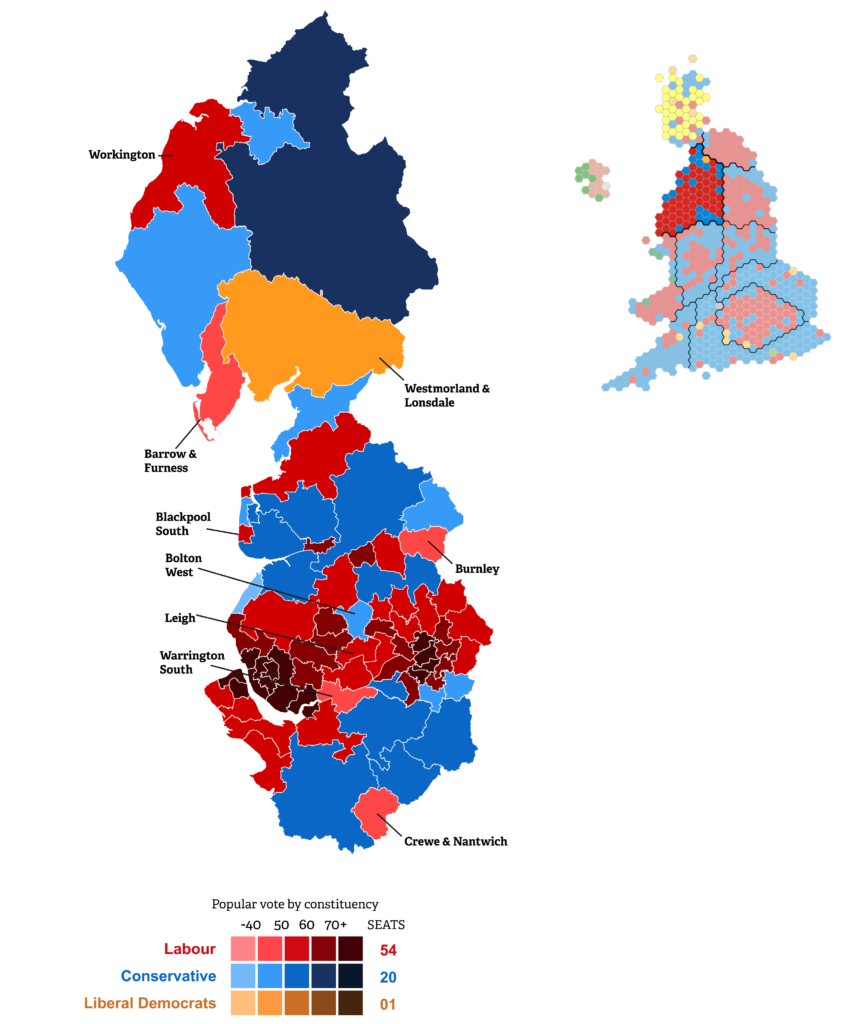
Source: Adapted from map by DrRandomFactor & Ch1902 /Wikipedia. Key constituency contests for 2019 labelled.
The map above highlights some of the key seats in the North West in 2019, discussed below. For all seats, you can find full details of all the candidates standing in 2019 and their social media links at DemocraticDashboard.com. It also gives complete results from the 2017 general election and estimated 2016 EU referendum results by constituency so you can best make up your own mind how to vote.
The estimated constituency results for all seats in 2019, and regional vote shares given in figures 1 and 2 come from YouGov’s large MRP poll published on 27 November, which are the best available estimates at time of writing. A sample of 100,319 people was polled across the UK, and used, along with demographic and other data, to create estimates for each constituency.
Figure 1: Number of seats won by each party at the last three general elections in the North West, and latest estimates from YouGov polling (27 November)
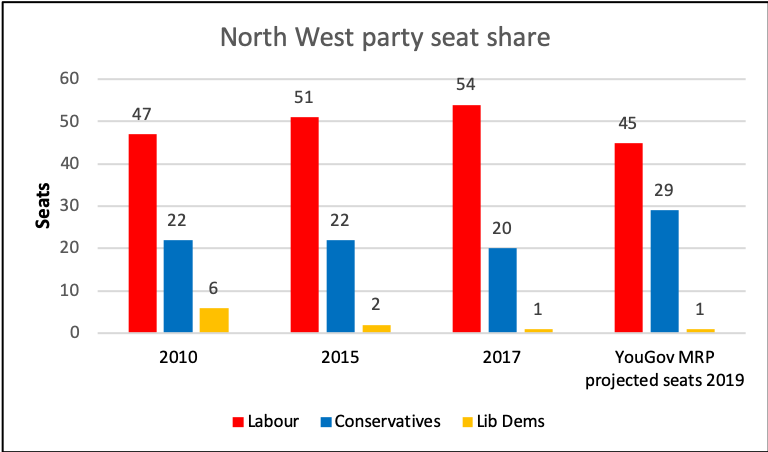
2019 figures from YouGov MRP seat estimates, 27 November
Figure 2: Parties’ shares of the votes in the North West at the last three general elections, and estimated shares in 2019 polling by YouGov (27 November)
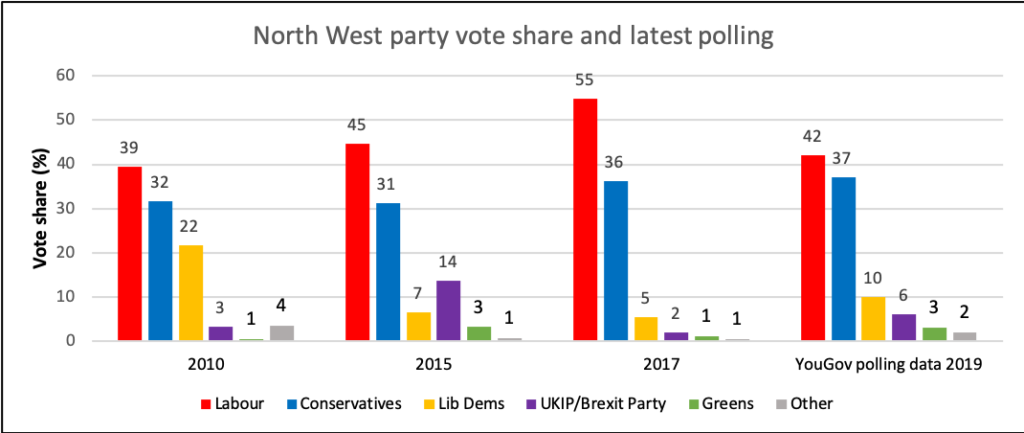
2019 data from Benjamin Lauderdale and Jack Blumenau for YouGov, 27 November.
Labour seats the Conservative are targeting
According to YouGov’s MRP (see Figure 1), there are nine seats that on current polling would switch from the Labour to the Conservatives in the North West, making it an important region for both main parties. However it’s worth noting these range from ultra-marginal Barrow and Furness, which YouGov’s MRP ranks as the seat most likely to switch from Labour to the Conservatives in the country, to ones with much lower probabilities, such as Leigh. In Barrow and Furness, the Conservatives were further helped when outgoing MP John Woodcock, formerly Labour but sitting as an Independent since 2018, endorsed the Conservatives this election.
These nine in full are: Barrow and Furness, Blackpool South, Bury South, Crewe and Nantwich, Hyndburn, Leigh, Warrington South, Weaver Vale and Workington.
Of these, Crewe and Nantwich was the most marginal seat in the North West in 2017, taken by Labour from the Conservatives with just a 48 seat majority. The Conservatives had won this seat from Labour in a 2008 by-election and held it continuously until 2017. As a current Labour seat it does have a Brexit Party candidate standing.
Greater Manchester mayor Andy Burnham’s former seat of Leigh would be the biggest scoop for the Conservatives in the region. In 2017 Burnham’s successor Jo Platt took the seat with a 20% majority over the Conservatives. The YouGov poll estimates this would be overturned and the Conservatives would win by 1% (statistically essentially a toss-up), on 40% with Labour on 39%, with the Lib Dems on 7% and Brexit Party estimated at 12%. Tactical switching by supporters of these smaller parties or undecided voters could easily change the result. Similarly Workington in Cumbria, now the cliché of the early campaign, where Labour currently has a majority of 9.4%, is essentially a toss-up, as is Weaver Vale, which only turned Labour in 2017.
There are other seats not included in these nine that are forecast for an equally close result, but just in Labour’s favour according to YouGov’s data. If the Conservatives improve their vote by a percentage or two, or squeeze the Brexit Party, Bolton North East and Bury North would be the next two to switch, along with Heywood and Middleton, where a high Brexit Party estimated vote of 14% affects the result: Conservatives are currently estimated at 38% to Labour’s 40%.
Other seats that could be targets for the Conservatives include Burnley, a Leave voting seat that Labour took from the Lib Dems in 2015. On the latest YouGov polling the Lib Dems slump to 9% and it is the Brexit Party who are the third-party challengers. The YouGov data here puts them on 16%, to the Conservatives’ 31% and Labour’s 39%. A split in the Leave vote appears to be benefiting Labour in this case.
Seats the Conservatives are defending
On the latest polling, Conservatives are sure of maintaining their current seats and adding to them in the North West. However, their most marginal seat in the region, Bolton West, where they currently have just 1.8% majority, was Labour until 2010 and is a Labour target. Jennifer Williams at the Manchester Evening News has identified it as one seat where conflicting on-the-ground reports and a concerted effort by Labour activists make the forecast more complex, with a possibility these tilt the results in Labour’s favour. The Conservatives only gained Copeland in 2017, and Pendle and Morecambe and Lunesdale are all marginal (see Figure 3 below). However, the Conservatives are helped by the lack of a Brexit Party candidate in all these seats.
Seats the Liberal Democrats are defending and targeting
For the Lib Dems, there are four seats in the North West where the Green Party is standing down to aid their prospects, as part of the ‘Unite to Remain’ agreement. This includes the Lib Dems’ single seat in the region, the marginal Westmoreland and Lonsdale, which former leader Tim Farron has been MP for since 2005, which they have a chance of holding, but the YouGov estimate places as a very tight race.
Southport has a long Liberal Democrat (and Liberal party) history, with the party holding the seat between 1997 and 2017 when it was lost to the Conservatives, in part because of a three-way split in the vote. Like Merseyside as a whole it voted Remain, and it is currently the only non-Labour seat here, so Labour hope to build on recent local election wins to take the seat for the first time. In 2019, the YouGov seat estimate again indicates such a three-way split in the vote, with Conservatives on 46%, Labour on 31% and Lib Dems on 23%, and so tactical Remain sites unanimously recommend a Labour vote. No Brexit Party candidate is standing.
Cheadle and Hazel Grove are the two other seats with Lib Dem-Green agreements in place, with the Lib Dems standing in both; they held both seats until 2015 and were second placed in both in 2017. Cheadle voted 57% remain, and the Lib Dems are polling a strong second here still. For both, Remain-focused tactical voting sites recommend a Lib Dem vote.
One final seat the Lib Dems seemed keen to target early in the campaign, but now seems like a long shot, is Altrincham and Sale West. This is a safe Conservative seat held by former Chair of the 1922 committee Graham Brady, who had a 12% majority over Labour in 2017. It has a Remain-leaning electorate (est. Remain vote 61%), which was the underlying rationale for former Labour MP, now Liberal Democrat candidate, Angela Smith to stand here rather than her previous seat of Penistone and Stocksbridge. However, on YouGov’s polling it remains safely Conservative with Labour second-placed and Lib Dems considerably behind.
Figure 3: North West most marginal seats (by % vote) from the 2017 election
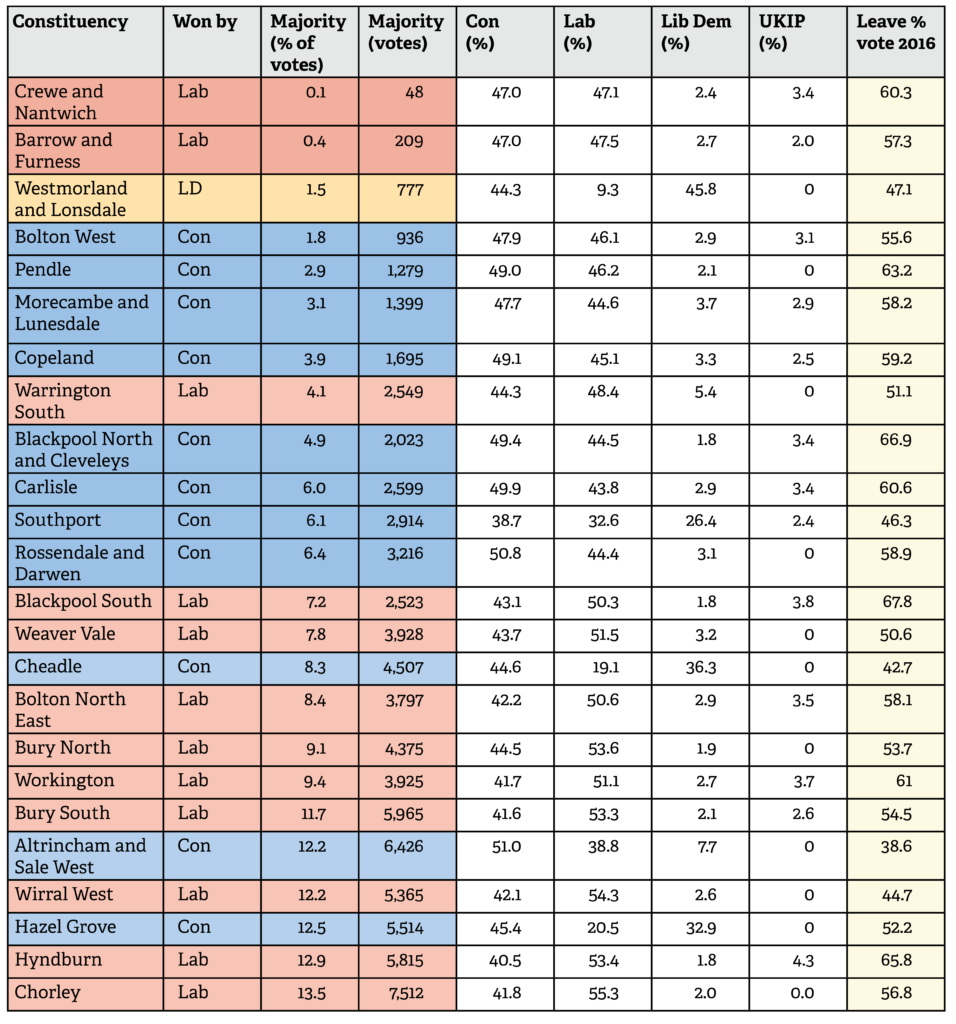
Note: The Leave % for each the 2016 Brexit referendum by constituency (and mentioned throughout this article), are Chris Hanretty’s estimates. You can also find these for each constituency (including those we don’t discuss), along with general election results at DemocraticDashboard.com.





 Democratic Audit's core funding is provided by the Joseph Rowntree Charitable Trust. Additional funding is provided by the London School of Economics.
Democratic Audit's core funding is provided by the Joseph Rowntree Charitable Trust. Additional funding is provided by the London School of Economics.
Avid election watcher. Very interested to see your report on the South including my constituency, Winchester